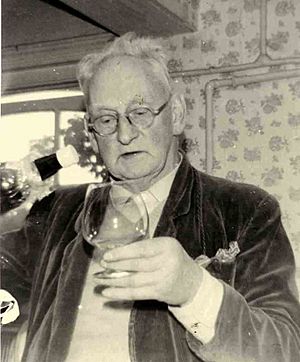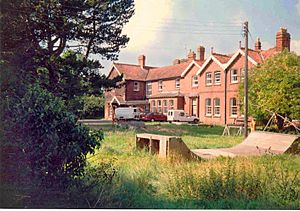A. S. Neill facts for kids
Quick facts for kids
A. S. Neill
|
|
|---|---|
 |
|
| Born |
Alexander Sutherland Neill
17 October 1883 Forfar, Scotland
|
| Died | 23 September 1973 (aged 89) |
| Occupation | Educator, author |
| Known for | Founding Summerhill School, advocacy of personal freedom for children, progressive education |
Alexander Sutherland Neill (born October 17, 1883 – died September 23, 1973) was a Scottish teacher and writer. He is famous for founding Summerhill School, a unique school where children had a lot of freedom and helped make the rules. Neill believed children should learn and grow without too much control from adults.
Neill grew up in Scotland and taught at different schools. He later studied at the University of Edinburgh. Before World War I, he worked in journalism. During the war, he taught at Gretna Green Village School and wrote his first book, A Dominie's Log, in 1915. This book was like a diary of his time as a head teacher. In 1921, he joined a progressive school in Dresden, Germany. He started Summerhill in England in 1924. His school became well-known in the 1930s and again in the 1960s and 1970s. This was because people were interested in new ways of teaching and counter-culture ideas. Neill wrote 20 books. His most popular book was Summerhill, published in 1960. It was widely read by people who supported the free school movement.
Contents
Who Was A. S. Neill?
Alexander Sutherland Neill was born in Forfar, Scotland, on October 17, 1883. He was one of eight children. He grew up in a very strict home with strong religious rules. He later disagreed with these rules. As a child, he was quiet and did not like school much. His father was a schoolmaster, and his mother had been a teacher.
Neill's Early School Days
In those days, Scottish schools often used physical punishment. Neill was afraid of his father, but he also learned from his father's teaching style. Many people believe Neill's childhood experiences led to his ideas about education.
When he was 14, Neill was expected to go to a better school. Instead, he worked as a clerk in a factory in Edinburgh. He hated the job and was homesick. His parents felt sorry for him, so he became an apprentice in a shop. He found this work boring.
At 15, Neill became his father's assistant teacher. The children liked him, even though school inspectors gave him low marks. He started to teach more subjects as he became more confident. He also became interested in math.
Becoming a Teacher
After four years, he tried to get into teacher training college but did not do well. He continued as a pupil teacher in other towns. He found the teaching methods there very strict and unpleasant. During this time, he learned Greek from a local priest. This made him more interested in learning and wanting to go to university. After studying hard, Neill passed his university entrance exam.
Neill then became an assistant teacher in Newport-on-Tay. This was a wealthy area. Here, he learned to dance and enjoy music and theater. He also started using more modern teaching methods. He stopped using physical punishment. Neill was friendly and relaxed with his students. He said these two years were "the happiest of [his] life so far." He finished his exams and became a fully certified teacher.
University and Early Career
In 1908, at age 25, Neill went to the University of Edinburgh. He first studied agriculture, as his father wanted him to have a good job. But he soon switched to English literature. He wrote for the university magazine and other newspapers. In his last year, he became the editor of the student paper. This helped him explore new ideas.
In his writings, Neill criticized boring lectures and too much focus on tests. He felt that true learning came from a student's own interest. He graduated in 1912. He then worked on encyclopedias and as an art editor. However, World War I started in 1914, and he joined the army. He later returned to Scotland and became a head teacher at Gretna Green School. His diary from this time became his first book, A Dominie's Log, which was well-received.
In 1921, Neill was invited to a progressive school in Dresden, Germany. This school later moved to Austria. In 1924, he moved back to England and started Summerhill School in Lyme Regis.
Summerhill School: A Place of Freedom
Summerhill School became quite famous. It usually had about 40 students. In 1927, the school moved to Leiston, where it has been ever since.
Neill believed that the school's environment, not just his own actions, helped students grow. He used to offer special talks to children who had problems from other schools. But he later found that love, support, and freedom worked even better.
Many people thought Summerhill classrooms were very different. However, the classes themselves were quite traditional. Neill cared more about students being happy than about how lessons were taught. He didn't think the quality of lessons was the most important thing. He believed that teaching methods didn't matter much if students were truly interested. Some critics said his teaching was not very engaging. Neill felt that too much "charismatic" teaching could actually make children less independent.
Neill was not religious. But he would joke that Summerhill was the only Christian school in England because its ideas were similar to Christ's teachings about love. Neill believed that the idea of "original sin" was used to control people. He wanted a world based on love and self-understanding.
Neill's Ideas on Education
Neill believed that children are naturally good. He thought that if children were allowed to grow without adults forcing their ideas of right and wrong, they would become fair and good people. He felt that children didn't need to be pushed into good behavior. Their natural state was fine, and their natural feelings were "in no way immoral." If left alone, children would become responsible and ethical adults.
Neill believed in giving children the freedom to live as they pleased, without adults interfering too much. He called this being "on the side of the child." His approach was about giving children:
- Space and time to explore on their own.
- Freedom from adult fears and pressure.
Finding Happiness and Interest
For Neill, the goal of life was "to find happiness, which means to find interest." So, the purpose of education at Summerhill was for children to be happy and interested in life. He thought children needed complete freedom to find what interested them. Neill believed happiness was something people were born with. If children were not given personal freedom, this happiness would fade. This could lead to unhappy adults with psychological problems. He blamed a "sick and unhappy" society for widespread unhappiness.
Neill felt that society passed on fears about life, children, and emotions to the next generation. He thought that when children were not allowed to express themselves, they might turn to self-hate. Neill believed that demands for obedience stopped children's natural needs. He hoped a school like Summerhill could help fulfill these needs.
Neill also thought that "interest" came naturally and was needed for learning. He saw forced teaching (when students weren't interested) as a waste of time. He believed that education should help people release their emotions.
Freedom, Not License
When Neill talked about children being free, he didn't mean they could do anything they wanted. He meant freedom without "license." This means everyone can do as they like, as long as it doesn't stop someone else from being free. Adults should protect children from danger, but not control their self-regulation. Neill stressed that adults stepping back from children's affairs was different from ignoring their safety. He felt that children would naturally learn their own limits.
Neill believed in equal rights for parents and children. He thought that homes became "disciplined" or "spoiled" when these rights were out of balance. He didn't think it was necessary to give children everything they asked for. He disliked spoiled children. Summerhill students were naturally limited by the school's teaching abilities and money.
Self-Governance at Summerhill
A main idea at Summerhill was self-governance. This was perhaps its "most fundamental feature." Summerhill held a weekly meeting where the school's rules were decided, and problems were solved. Everyone in the community, both staff and students, had one vote. Most people at the school attended, and students always had the most votes. An elected Chairperson ran the meetings. Sometimes, the school had over 200 rules.
Summerhill aimed to help students become independent thinkers who were aware of their community. The general meeting replaced teacher authority with community control. This freed teachers from being disciplinarians. It also taught children about democracy and the importance of rules. Disputes between teachers and students were rare. Neill felt that the community's authority never made people resentful. He believed self-governance was "the most valuable asset in education and life." He thought the general meeting was "more important than all the textbooks in the world."
Sometimes, Neill, as the school owner, made decisions on his own. This happened if a discussion went on too long, or if he felt it was necessary. But generally, the school's freedom was structured by him.
Neill's Books
Neill wrote 20 books during his life. His writing style was simple and friendly. He wrote about the balance of authority and how thoughts and feelings are connected.
The Book Summerhill
The release of his book Summerhill in 1960 made Neill very famous. It led to many "Summerhill-like" schools and support groups in America. The book sold very well and made Neill a leader in new educational ideas. The book's message was easy to understand. It also encouraged other education critics that their ideas could work.
See also
 In Spanish: Alexander Sutherland Neill para niños
In Spanish: Alexander Sutherland Neill para niños


